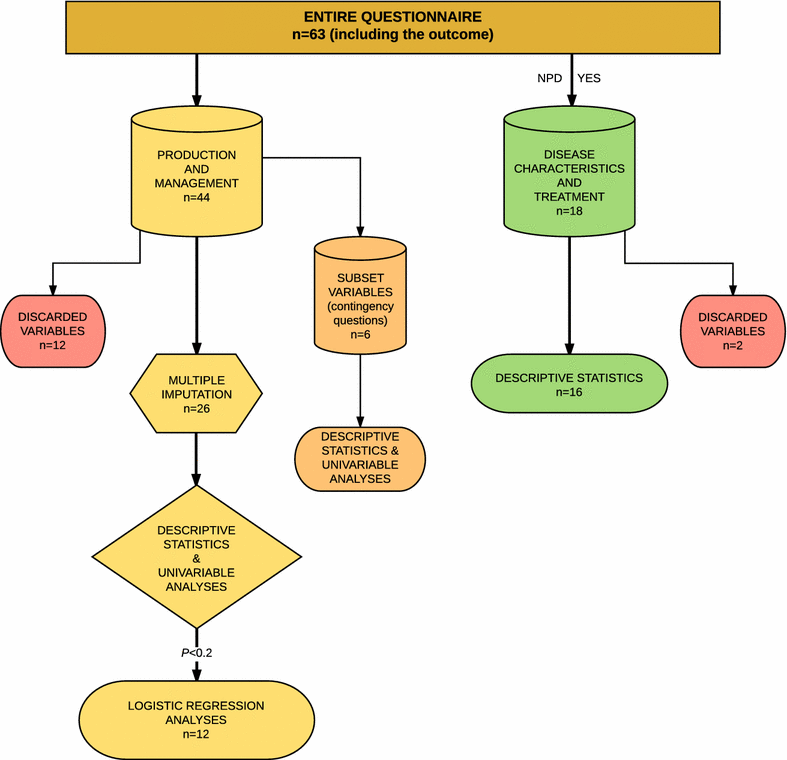Farm characteristics and management routines related to neonatal porcine diarrhoea: a survey among Swedish piglet producers
- PMID: 27832811
- PMCID: PMC5103491
- DOI: 10.1186/s13028-016-0261-0
Farm characteristics and management routines related to neonatal porcine diarrhoea: a survey among Swedish piglet producers
Abstract
Background: In recent years reports from a number of countries, including Sweden, describe problems with diarrhoea in newborn piglets despite the use of previously effective preventive measures. This seemingly altered disease pattern of neonatal porcine diarrhoea (NPD) warrants investigations on the magnitude and manifestation of the problem. The aim of the present study was to investigate the herd-level prevalence of NPD in Sweden and to describe disease characteristics and intervention strategies used in affected herds. To obtain this information a questionnaire was developed and sent out to 170 randomly selected herds. The presence of NPD in the herds was specified as "Yes", "No" or "Occasional cases" during the preceding year.
Results: A response rate of 58% (98/170) was achieved. The total prevalence of farmer experienced NPD, including occasional cases was 79.6% (95% CI 70.6-86.4%). Most herds (85%; 83/98) employed maternal vaccination against enterotoxigenic Escherichia coli (ETEC). The most common treatment regimens used in affected herds included antimicrobials only (43%; 18/42) or antimicrobials in combination with supplementary fluids (33%; 14/42). Trimethoprim in combination with a sulphonamide was the drug of choice in 57% (24/42) of the affected herds whereas the remaining herds used a broad range of other antimicrobials (neomycin, amoxicillin, fluoroquinolones, penicillin, and tylosin). Furthermore, the risk of experiencing NPD was found to be higher in herds with >200 sows (OR = 4.0) compared to herds with <200 sows and in herds where more ambitious efforts (such as providing supplemental colostrum or practicing split-suckling) were made to save weak-born piglets (OR = 4.4).
Conclusions: The results of the present study indicate that Swedish farmers commonly experience NPD in their herds, often despite vaccination against ETEC. Considering the extent of this problem and its contribution to antimicrobial usage, improving alternative control strategies for NPD needs to be prioritized.
Keywords: Neonatal porcine diarrhoea; New neonatal porcine diarrhoea; Pigs; Prevalence; Prevention; Risk factors; Swine; Treatment.
Figures

Similar articles
-
On the Infectious Causes of Neonatal Piglet Diarrhoea-A Review.Vet Sci. 2022 Aug 10;9(8):422. doi: 10.3390/vetsci9080422. Vet Sci. 2022. PMID: 36006337 Free PMC article. Review.
-
Antimicrobial resistance in Escherichia coli from Swedish piglets with diarrhoea and associations with potential risk factors.Acta Vet Scand. 2025 Apr 2;67(1):16. doi: 10.1186/s13028-025-00795-9. Acta Vet Scand. 2025. PMID: 40176081 Free PMC article.
-
Risk factors and epidemiological characteristics of new neonatal porcine diarrhoea syndrome in four Danish herds.BMC Vet Res. 2014 Jul 10;10:151. doi: 10.1186/1746-6148-10-151. BMC Vet Res. 2014. PMID: 25012922 Free PMC article.
-
The effect of antimicrobial growth promoter withdrawal on the health of weaned pigs in Finland.Prev Vet Med. 2004 Dec 15;66(1-4):163-74. doi: 10.1016/j.prevetmed.2004.09.001. Prev Vet Med. 2004. PMID: 15579342
-
Microbiological, pathological and histological findings in four Danish pig herds affected by a new neonatal diarrhoea syndrome.BMC Vet Res. 2013 Oct 12;9:206. doi: 10.1186/1746-6148-9-206. BMC Vet Res. 2013. PMID: 24119974 Free PMC article.
Cited by
-
Feed additives for the control of post-weaning Streptococcus suis disease and the effect on the faecal and nasal microbiota.Sci Rep. 2020 Nov 23;10(1):20354. doi: 10.1038/s41598-020-77313-6. Sci Rep. 2020. PMID: 33230191 Free PMC article.
-
On the Infectious Causes of Neonatal Piglet Diarrhoea-A Review.Vet Sci. 2022 Aug 10;9(8):422. doi: 10.3390/vetsci9080422. Vet Sci. 2022. PMID: 36006337 Free PMC article. Review.
-
Presence of toxin-producing bacterial pathogens and associated risk factors in neonatal diarrhea of piglets on commercial sow farms in Vietnam.Vet World. 2025 May;18(5):1288-1296. doi: 10.14202/vetworld.2025.1288-1296. Epub 2025 May 21. Vet World. 2025. PMID: 40584133 Free PMC article.
-
Microbiological Findings and Associated Histopathological Lesions in Neonatal Diarrhoea Cases between 2020 and 2022 in a French Veterinary Pig Practice.Vet Sci. 2023 Apr 21;10(4):304. doi: 10.3390/vetsci10040304. Vet Sci. 2023. PMID: 37104459 Free PMC article.
References
-
- Thomson JR, Friendship RM. Digestive system. In: Zimmerman JJ, Karriker LA, Ramirez A, Schwartz KJ, Stevenson GW, editors. Diseases of Swine. 10. Chichester: Wiley-Blackwell; 2012. pp. 216–218.
-
- Sjölund M, Zoric M, Wallgren P. Financial impact of disease on pig production. Part III. Gastrointestinal disorders. In: proceedings of the 6th European symposium of Porcine Health Management. Italy: Sorrento; 2014.
-
- Martineau GP, Vaillancourt JP, Broes A. Principal Neonatal Diseases. In: Varley MA, editor. The Neonatal Pig-Development and Survival. Wallingford: CAB International; 1995. pp. 239–264.
-
- Drew M, Owen B. The provision of passive immunity to colostrum-deprived piglets by bovine or porcine serum immunoglobulins. Can J Anim Sci. 1988;68:1277–1284. doi: 10.4141/cjas88-143. - DOI
MeSH terms
LinkOut - more resources
Full Text Sources
Other Literature Sources
Medical

